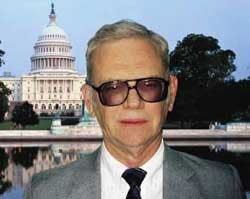By John Rhea
WASHINGTON — There's a book I'd like to recommend for the top of President Bush's reading list: Welcome to Moonbase, by Ben Bova and published in 1987 by Ballantine Books.
His country's first President with an MBA degree (from Harvard, no less) has a White House interagency working group laying the groundwork for a space spectacular to restore confidence in NASA after the tragic loss of the space shuttle Columbia last Feb. 1. A leading candidate is a return to the moon, and first details should emerge in President Bush's State of the Union speech this month.
There's one problem: the days of space spectaculars are over; that's the reason this idea won't work today — unless serious consideration goes to the underlying economics. That's where the book by Ben Bova, a noted science fiction writer, former president of the National Space Society, and longtime friend of mine, is so important.
Writing the year after the space shuttle Challenger tragedy, he envisioned a lunar base as essentially a government investment in an infrastructure that would exploit the mineral resources of the moon as well as enhancing astronomical research. He also envisioned lunar tourism.
I think that kind of government investment in infrastructure would be consistent with the free-market economy foreseen by Adam Smith in his Wealth of Nations, published in that wonderful year of 1776. There may not be any mineral resources on the moon to exploit, but if there are and we don't stake our claim to them, we'll be buying them from somebody else.
President Kennedy's famous challenge in 1961 to land a man on the moon and return him safely in the decade of the 1960s would hardly have met Adam Smith's criteria.
It didn't have to. The international climate was much different then. The sole purpose of the Apollo program was to show the rest of the world that the United States was determined to match — and exceed — the Russians' accomplishments in space.
I remember we used to joke about it at the time (Sample question: what will the astronauts need when they get to the moon? Answer: Russian visas). Nonetheless we were all confident that President Kennedy's deadline would be met.
In that regard Apollo was remarkably successful. The program was completed on time and at the lower end of the original cost estimates ($23 billion when figures ranging from $20 billion to $40 billion were cited) — not all that common for government programs.
For that money, however, the astronauts spent less than two weeks on the moon and brought back 845 pounds of lunar rocks before NASA had to cancel the program in 1972 as the nation was embroiled in the war in Vietnam and racial unrest.
President Bush's father (41) engineered his own photo op with a call on July 20, 1989 — the 20th anniversary of the first Apollo landing — for astronauts to plant the American flag on Mars by the 50th anniversary, or 2019.
Neither he nor 43 seems to have realized that the days of big government are over. President Reagan talked the talk ("Government is not the solution; government is the problem"), and President Clinton walked the walk, balancing the federal budget for the first time since the Eisenhower Administration.
The first President Bush's extravaganza was estimated to cost $500 billion, and the ideas bandied about the White House today aren't likely to be any cheaper. The public relations value of beating the Russians — or now the Chinese — won't justify that kind of expenditure.
Nor is the electronics industry likely to reap much benefit from any new space spectaculars. Companies in the industry were minor players during Apollo. The onboard computer had a total memory of 39,000 words, much of it provided by single-function transistors. There's more digital logic in the $19 Casio watch I bought at Wal-Mart a couple years ago than there was in the entire Apollo space vehicle, including the Saturn V launch vehicle.
Revenues to the electronics industry from any new one-shot space ventures are likely to amount to about one day's worth of shipments to the telecommunications or video games industries.
The current era of commercial off-the-shelf (COTS) technology naturally fits with what should be the reduced role of government. The notion that technology was "spun off" from Apollo and other NASA activities was shaky at best at the time and amounts to a non sequitur today.
This is not to say that federal support of research is obsolete. I think even Adam Smith would agree to its necessity. What seems evident in today's climate is the research, which should be defined in its own terms and not expected to be a serendipitous byproduct of other activities. This is where Ben Bova's book is so inspiring. A coordinated program of scientific research and commercial exploitation could readily involve all the nations of the world rather than degenerating into a game of one-upmanship in space.
The logical umbrella agency would be the United Nations despite its current low esteem in American public opinion. International cooperation has a proven track record. The United States is cooperating now with the Russians on the space station, and I don't see any need for the Chinese to reinvent the wheel.
This, in turn, means establishing ground rules for any international lunar effort. In the late 1980s there was considerable controversy over something known as the Moon Treaty, which would have treated the moon essentially like Antarctica and prevented any profit-oriented activities. This issue needs to be resolved before any sustainable human presence on the moon can be initiated.
Even as the Apollo program was beginning to wind down, NASA had begun studies on a follow-on program, the Apollo Applications Program. That idea could be resurrected and form the basis for any new program that is consistent with today's global economy.
Welcome to moonbase.

